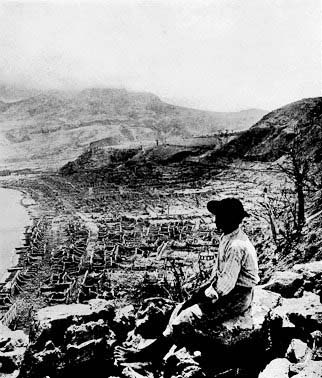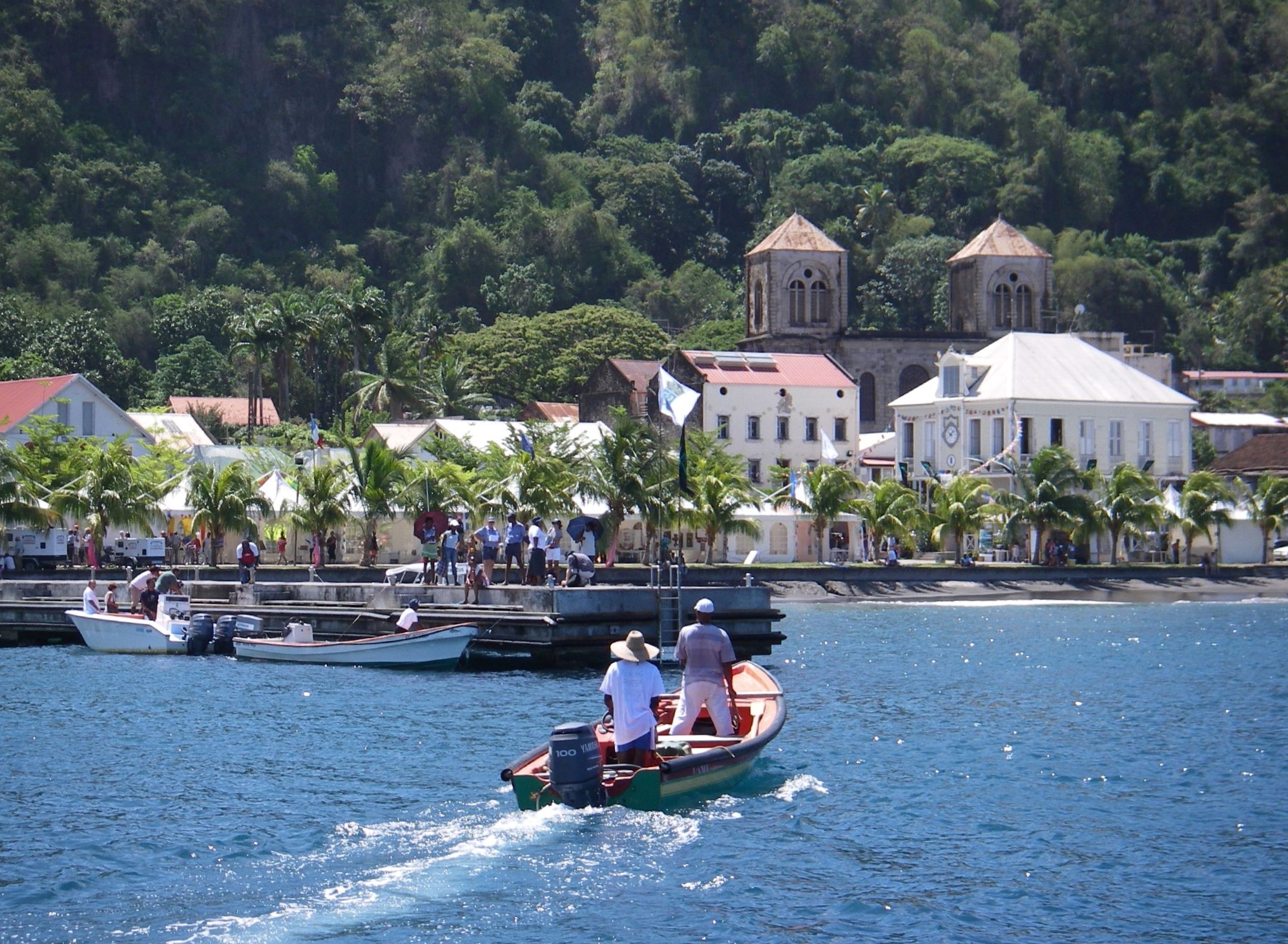Saint-Pierre, Martinique on:
[Wikipedia]
[Google]
[Amazon]
Saint-Pierre (, ; ;



 The town was again destroyed in 1902, when the
The town was again destroyed in 1902, when the 
City of Saint-Pierre description from English edition of official Martinique website
{{DEFAULTSORT:Saintpierre Communes of Martinique Subprefectures in France Populated places in Martinique Populated places established in 1635 1635 establishments in the French colonial empire
Martinican Creole
Antillean Creole (Antillean French Creole, Kreyol, Kwéyòl, Patois) is a French-based creole that is primarily spoken in the Lesser Antilles. Its grammar and vocabulary include elements of Carib, English, and African languages.
Antillean Creol ...
: ) is a town and commune
A commune is an alternative term for an intentional community. Commune or comună or comune or other derivations may also refer to:
Administrative-territorial entities
* Commune (administrative division), a municipality or township
** Communes of ...
of France
France (), officially the French Republic ( ), is a country primarily located in Western Europe. It also comprises of Overseas France, overseas regions and territories in the Americas and the Atlantic Ocean, Atlantic, Pacific Ocean, Pac ...
's Caribbean
The Caribbean (, ) ( es, El Caribe; french: la Caraïbe; ht, Karayib; nl, De Caraïben) is a region of the Americas that consists of the Caribbean Sea, its islands (some surrounded by the Caribbean Sea and some bordering both the Caribbean Se ...
overseas department of Martinique
Martinique ( , ; gcf, label=Martinican Creole, Matinik or ; Kalinago: or ) is an island and an overseas department/region and single territorial collectivity of France. An integral part of the French Republic, Martinique is located in th ...
, founded in 1635 by Pierre Belain d'Esnambuc
Pierre Belain, sieur d'Esnambuc (; 1585–1636) was a French trader and adventurer in the Caribbean, who established the first permanent French colony, Saint-Pierre, on the island of Martinique in 1635.
Biography Youth
Pierre Belain d'Esnambuc ...
. Before the total destruction of Saint-Pierre by a volcanic eruption in 1902, it was the most important city of Martinique culturally and economically, being known as "the Paris of the Caribbean". While Fort-de-France
Fort-de-France (, , ; gcf, label=Martinican Creole, Fodfwans) is a Communes of France, commune and the capital city of Martinique, an overseas department and region of France located in the Caribbean. It is also one of the major cities in the ...
was the official administrative capital, Saint-Pierre was the cultural capital of Martinique. After the disaster, Fort-de-France grew in economic importance.
History
Saint-Pierre was founded in 1635 byPierre Belain d'Esnambuc
Pierre Belain, sieur d'Esnambuc (; 1585–1636) was a French trader and adventurer in the Caribbean, who established the first permanent French colony, Saint-Pierre, on the island of Martinique in 1635.
Biography Youth
Pierre Belain d'Esnambuc ...
, a French trader and adventurer
An adventure is an exciting experience or undertaking that is typically bold, sometimes risky. Adventures may be activities with danger such as traveling, exploring, skydiving, mountain climbing, scuba diving, river rafting, or other extreme sp ...
, as the first permanent French colony on the island of Martinique.
The Great Hurricane of 1780
The Great Hurricane of 1780 was the deadliest Atlantic hurricane on record. An estimated 22,000 people died throughout the Lesser Antilles when the storm passed through the islands from October 10 to October 16. Specifics on the hurricane's tra ...
produced a storm-surge of which "inundated the city, destroying all houses" and killed 9,000 people.

Eruption of Mount Pelée


 The town was again destroyed in 1902, when the
The town was again destroyed in 1902, when the volcano
A volcano is a rupture in the crust of a planetary-mass object, such as Earth, that allows hot lava, volcanic ash, and gases to escape from a magma chamber below the surface.
On Earth, volcanoes are most often found where tectonic plates are ...
Mount Pelée
Mount Pelée or Mont Pelée ( ; french: Montagne Pelée, ; gcf, label=Antillean Creole, Montann Pèlé, meaning "bald mountain" or "peeled mountain") is an active volcano at the northern end of Martinique, an island and French overseas departmen ...
erupted, killing 28,000 people. The entire population of the town, as well as people from neighboring villages who had taken refuge in the supposedly safe city, died, except for three people—a young girl, Havivra da Ifrile, a prisoner by the name of Louis-Auguste Cyparis
Ludger Sylbaris (1 June 1874 – 1929, aged 55) was an Afro-Caribbean man who was one of the survivors in the city of Saint-Pierre on the Caribbean island of Martinique during the 1902 eruption of Mount Pelée on May 8, 1902. Saint-Pierre, ...
(known also by various other names), who later toured the world with the Barnum and Bailey Circus
The Ringling Bros. and Barnum & Bailey Circus (also known as the Ringling Bros. Circus, Ringling Bros., the Barnum & Bailey Circus, Barnum & Bailey, or simply Ringling) is an American traveling circus company billed as The Greatest Show on Ear ...
, and Léon Compère-Léandre
Léon Compère-Léandre (1874?–1936) was a Martiniquais shoemaker in Saint-Pierre on the French Caribbean island of Martinique when Mount Pelée erupted on May 8, 1902, and destroyed the town. He was one of only 2 (arguably 3) known survivors. ...
, who lived at the edge of the city.
Legend has it that the town's doom was forecast by loud groaning noises from within the volcano, but the mayor
In many countries, a mayor is the highest-ranking official in a municipal government such as that of a city or a town. Worldwide, there is a wide variance in local laws and customs regarding the powers and responsibilities of a mayor as well a ...
of the town had it blocked off to prevent people from leaving during an election
An election is a formal group decision-making process by which a population chooses an individual or multiple individuals to hold public office.
Elections have been the usual mechanism by which modern representative democracy has opera ...
. This story appears to have originated with one of the island's newspapers, published by a political opponent of the governor. Actually, there was considerable eruptive activity in the two weeks prior to the fatal blast, but since the phenomenon of the pyroclastic flow
A pyroclastic flow (also known as a pyroclastic density current or a pyroclastic cloud) is a fast-moving current of hot gas and volcanic matter (collectively known as tephra) that flows along the ground away from a volcano at average speeds of b ...
(french: nuée ardente) was not yet understood, the danger was perceived to be from lava
Lava is molten or partially molten rock (magma) that has been expelled from the interior of a terrestrial planet (such as Earth) or a moon onto its surface. Lava may be erupted at a volcano or through a fracture in the crust, on land or un ...
flows, which, it was believed, would be stopped by two valleys between the volcano and the city.

Climate
Temperature record
On 6 October 2010, Saint-Pierre recorded a temperature of , which is the highest temperature to have ever been recorded in Martinique.Climate data of Saint-Pierre
Saint-Pierre has atropical monsoon climate
An area of tropical monsoon climate (occasionally known as a sub-equatorial, tropical wet climate or a tropical monsoon and trade-wind littoral climate) is a tropical climate sub-type that corresponds to the Köppen climate classification category ...
(Köppen climate classification
The Köppen climate classification is one of the most widely used climate classification systems. It was first published by German-Russian climatologist Wladimir Köppen (1846–1940) in 1884, with several later modifications by Köppen, notabl ...
''Am''). The average annual temperature in Saint-Pierre is . The average annual rainfall is with August as the wettest month. The temperatures are highest on average in August, at around , and lowest in January, at around . The highest temperature ever recorded in Saint-Pierre was on 6 October 2010; the coldest temperature ever recorded was on 3 February 2005.
Population
Today
The city of Saint-Pierre was never restored to its former entirety, though some villages were built in later decades on its place. Today, the town is the seat of the Arrondissement of Saint-Pierre. It has been designated as a " City of Art and History". There are many historic remains, and a Volcanological Museum ().See also
*Co-Cathedral of Our Lady of Assumption, Saint-Pierre
The Co-Cathedral of Our Lady of Assumption (french: Cathédrale Notre-Dame-de-l'Assomption de Saint-Pierre de la Martinique) or simply Cathedral of Our Lady of the Assumption, is the co-cathedral church of the Archdiocese of Fort-de-France, is loca ...
*Communes of the Martinique department
The following is a list of the 34 communes of the Martinique overseas department of France.
The communes cooperate in the following intercommunalities (as of 2020):Herculaneum
Herculaneum (; Neapolitan and it, Ercolano) was an ancient town, located in the modern-day ''comune'' of Ercolano, Campania, Italy. Herculaneum was buried under volcanic ash and pumice in the eruption of Mount Vesuvius in AD 79.
Like the nea ...
*Pompeii
Pompeii (, ) was an ancient city located in what is now the ''comune'' of Pompei near Naples in the Campania region of Italy. Pompeii, along with Herculaneum and many villas in the surrounding area (e.g. at Boscoreale, Stabiae), was buried ...
* Victor Cochinat (1819–1886), French journalist
*Georges Hébert
Georges Hébert (27 April 1875 – 2 August 1957) was a pioneering physical educator in the French military who developed a system of physical education and training known as "la méthode naturelle" ("Natural Method") and a more wide training pr ...
(1875–1957), French naval officer who witnessed the destruction by the volcano on the island in 1902, and went on to develop a physical training method from his experience
References
External links
*City of Saint-Pierre description from English edition of official Martinique website
{{DEFAULTSORT:Saintpierre Communes of Martinique Subprefectures in France Populated places in Martinique Populated places established in 1635 1635 establishments in the French colonial empire